Cherry blossoms, or ‘sakura’ in Japanese, are one of the country’s most loved flowers. Although Japan does not have an official national flower, cherry blossoms are widely popular. They are regarded as the de facto national flower, together with chrysanthemum, which represents the Imperial Family and is used in official government seals.
However, cherry blossoms are the most iconic when people think of Japan’s national flower because of its cultural significance.
In Japan, the cherry blossom season is a significant time of year. Many schools (from kindergarten to university) in Japan hold entrance and graduation ceremonies in late March and early April. Students graduate from elementary and junior high school, which coincides with the blooming of cherry blossoms in some regions. Besides ‘spring’, people feel cherry blossoms symbolise ‘new start’ (entrance to school) and ‘departure’ (graduation).
Cherry blossoms have also had a significant influence on the world of art. There are many poems about cherry blossoms in the ancient Manyoshu (the oldest existing poetry anthology in Japan, compiled in the 8th century) and many poems in the Kokin Wakashu (an imperial poetry anthology compiled in the early 10th century). Many ukiyoe prints developed during the Edo period (1603-1868) depict cherry blossoms, and Hiroshige Utagawa’s Meisho Edo hyakkei (One hundred views of famous places in Edo) and Hokusai Katsushika’s Fugaku sanjurokkei (Thirty-six views of Mount Fuji) show how ordinary people enjoy cherry blossom viewing.
The blog will explore the reasons why cherry blossoms are loved so much in Japan, their history, and the products made with them.
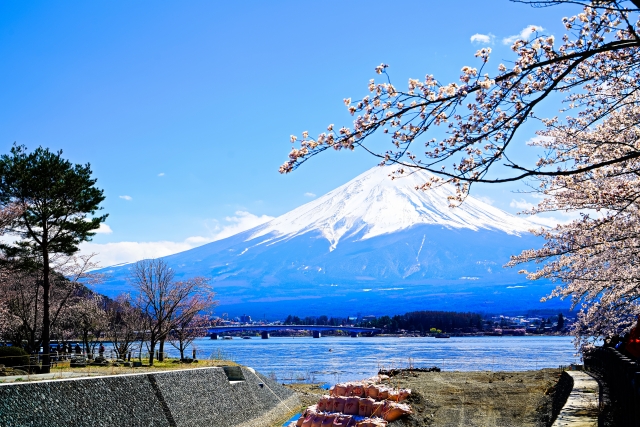
The origin of the name ‘Sakura’
Nihon Kokugo Daijiten, ‘the Unabridged Dictionary of the Japanese Language,’ the largest Japanese language dictionary published in Japan, lists 13 theories on the etymology of the word sakura. For example, one theory is that it derives from Princess Konohanasakuya, the spirit of cherry blossoms. It is said that ‘sakura’ comes from changing a part of her name, ‘sakuya’, to ‘sakura’.
Another theory says ‘sakura’ might be derived from the verb ‘saku’, meaning flowers blooming. ‘Ra’, used for plural form, might be added to ‘saku’ to express small flowers blooming all at once!
History of Cherry Blossoms in Japan
During the Yayoi period (BC300 or around BC800-900-300 AD), cherry trees were regarded as ‘sacred trees’ where the god of grain resided. It is said that the blossoming of the cherry trees signalled the start of the farming season and that there was a custom of divining the fertility of the rice crop for the coming year according to how well the cherry trees were in bloom.
Cherry trees’ flowering time is closely affected by temperature, and they start to bloom when the weather gets warmer. It is, therefore, assumed that rice cultivation was started based on when the cherry trees were in full bloom. The custom of predicting the good or bad harvest of the rice crop according to the blooming of the cherry trees also originated in the Yayoi period.
Why are cherry blossoms so favoured in Japan?
As mentioned earlier, cherry blossoms symbolise the arrival of spring. In Japan, where the four seasons are clearly defined, spring is an exciting season when the cold winter is over, the academic year (and so the Fiscal Year) has changed, and many things start afresh. One reason Japanese like cherry blossoms is that when they are in full bloom, they can feel the arrival of such an exciting season.
The second reason is that they are ‘ephemeral and beautiful flowers. Cherry blossoms take many processes to flower: flower bud formation, dormancy, breaking dormancy, and growth. Generally, flower bud formation occurs between August and early September of the previous year; then, the cherry tree enters dormancy. From December to February, low temperatures prevent the growth of flower buds. When temperatures begin to rise at the end of winter, the flower buds start to develop, and flowering begins around mid-late March, with full bloom occurring on average in about one week to ten days and fading in three to five days.
While they spend months preparing for flowering, cherry blossoms usually fall within two weeks at most. Since ancient times, the Japanese have always had an aesthetic appreciation for the transience of life, and it is thought that one of the reasons why the Japanese like cherry blossoms so much is that the beauty of cherry blossoms in full bloom is that they are ‘ephemeral flowers’ that end up falling in a short period of time. The short life of cherry blossom flowers reflects the Buddhist concept of impermanence (mujō)—everything in life is temporary and constantly changing, influencing their view of life and death. It also teaches people to cherish the present moment because life is fleeting like cherry blossoms.
When did flower viewing (‘hanami’) of cherry blossoms become popular?
Although cherry blossom viewing is popular now, plum blossoms were the most common flower appreciated in old times. The Manyoshu, compiled in the Nara Period (AD 710-794), contains more poems about plum blossoms than cherry blossoms. There are about 120 poems about plum blossoms and about 40 referring to cherry blossoms. This shows that plum blossoms were quite popular around the 8th century.
In the Heian period (794-1185), cherry blossom flowers came to be favoured at flower viewing. In the Kokin Waka Shu, which was compiled during the Heian period, about 30 poems were written about plum blossoms, while about 60 were written about cherry blossoms. Unlike in the Nara period, the popularity of cherry and plum blossoms has reversed.
This change came from discontinuing the Japanese envoys to the Tang Dynasty in China. When the envoys were sent to the Tang Dynasty, they were strongly influenced by Chinese culture – the plum blossom is one example. However, with the abolition of the Japanese envoys to the Tang Dynasty, Japan’s own culture began to develop. This is why the cherry blossom, which had been growing wild in Japan for a long time, attracted so much attention.
What was flower viewing like in old times?
Cherry blossom viewing began in the Heian period (794-1185). After the emperor started organising an annual flower-viewing banquet, aristocrats followed suit and held flower-viewing parties by themselves. It is said this could be the origin of flower viewing that we now have. At that time, aristocrats recited poems and played kemari (an ancient Japanese ball game) while viewing the cherry blossoms.
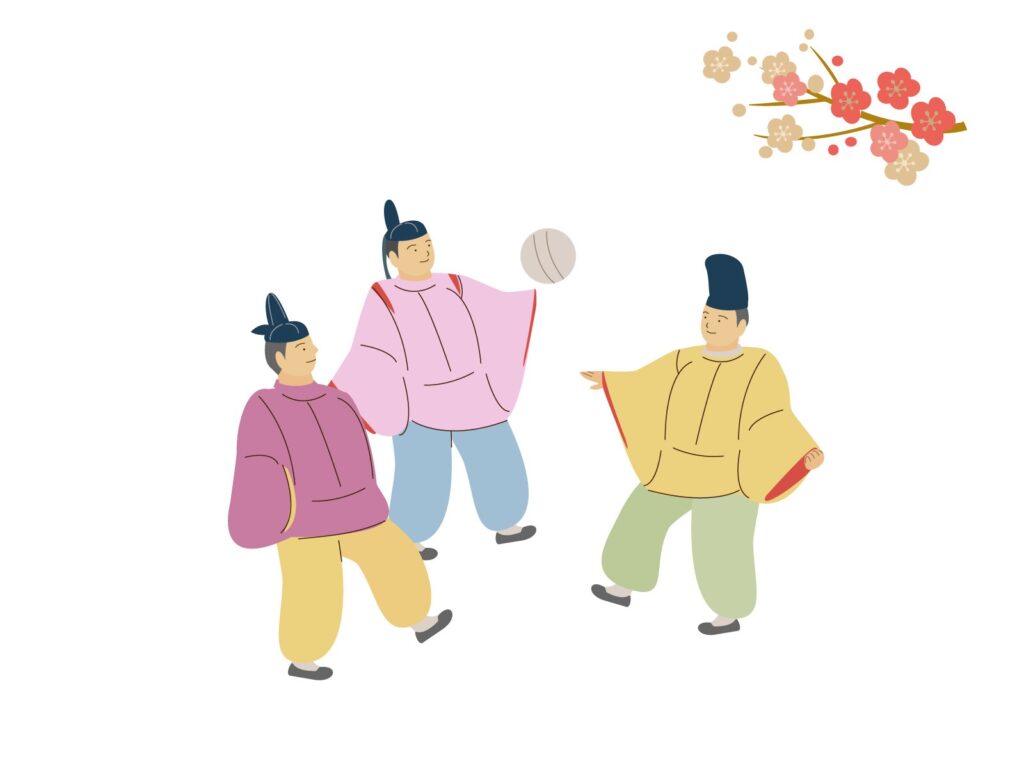
Until the Heian period, flower viewing was only for culture among aristocrats. By the Kamakura period (1992-1333), it had spread to the samurais, and samurais began to enjoy flower viewing in their domains. From this period, flower viewing changed to banqueting under cherry trees.
There was another origin of flower viewing. In spring, farmers used to hold ‘haru-uki’ or ‘haru-yama-iri’, where they sent back the god of the mountains, who was believed to bring winter and instead, welcomed the god of the rice fields, who was believed to bring spring. They spent a day under the cherry blossoms, eating and drinking the sake and food they had brought. It is said that farmers predicted the year’s harvest by looking at the colour of the cherry blossom flowers and how well they had opened. This was ‘flower viewing’ among the farmers.
Cherry blossom viewing was enjoyed only by aristocrats, samurais and farmers for a while. Around the late 17th century, flower viewing became known to the general public. In the beginning, people had flower viewing in the precincts of temples and shrines. However, in the 18th century, the 8th Shogun, Yoshimune Tokugawa, planted more than a thousand cherry trees on Asukayama (in Tokyo), and also at the Sumida Riverbank to encourage the general public to enjoy cherry blossom viewing. The cherry trees planted at the riverbank were also to prevent floods. At that time, the Sumida River was often flooded when it rained heavily. However, it was impossible to build dykes across the entire area where the Sumida River flows, so it is said that cherry trees planted along the river worked as a substitute for dykes. From this time onwards, people went out to see the cherry blossoms in bloom and enjoyed flower viewing while eating lunch under the cherry trees.
Cherry trees growing in Japan: species, their ecology and breeding grounds:
Cherry blossoms are tall deciduous trees or shrubs. In Japan, there are more than 100 species of cherry trees, including the yamazakura and the Oshimazakura, as well as variants, which grow wild in Okinawa (the Kanhi cherry). There are also more than 200 horticultural varieties bred from these.
Yamazakura (mountain cherry)
This is Japan’s most representative type of cherry tree and has long been popular in poetry and song. It is often found in secondary forests (forests that have regenerated after logging or wind and flood damage) in warm-temperate zones. It has long been a familiar cherry tree in the Kanto region and westwards. For this reason, it was much admired as an ornamental tree from the Heian period (794-1185) until the Edo period (1603-1868). It blooms at about the same time as the Somei-Yoshino, ahead of other trees in secondary forests, and let us know the arrival of spring.
Edohigan
This cherry tree grows wild and widely in Honshu, Shikoku, and Kyushu and blooms early. It is long-lived, and there are many giant and famous trees dotted around the country. Shidarezakura (weeping cherry tree) is the one with drooping branches.
Like the yamazakura, it is distributed over a wide area in Japan, from the Tohoku region to Kyushu. The large, old trees with magnificent flowers are carefully protected and admired as ‘ipponzakura’, and many wild species are designated natural monuments by the national and local governments. The flowering period is slightly earlier than that of the yamazakura and Somei-Yoshino cherry trees, and they show their vivid colours when in bloom.
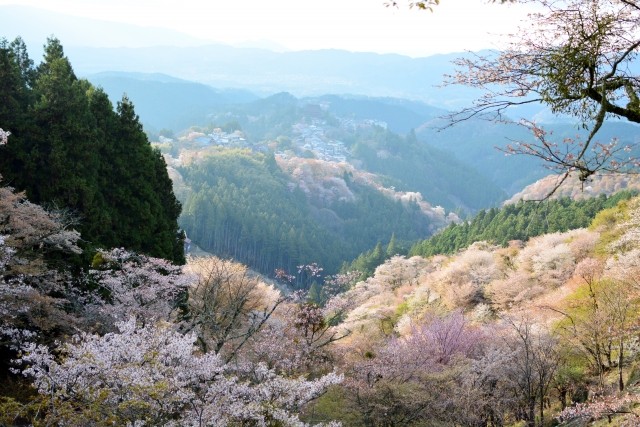
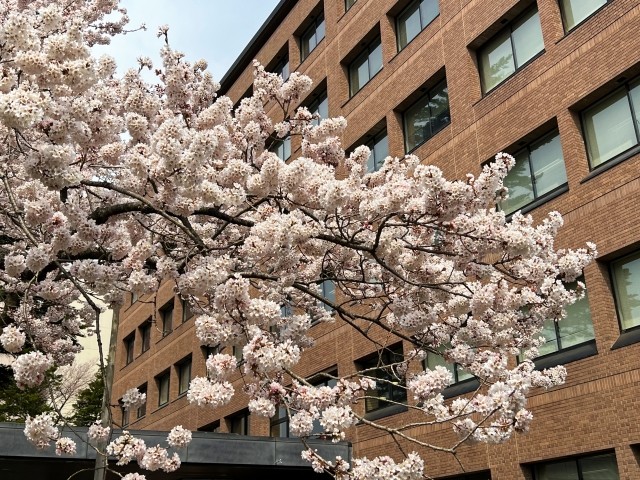
Oshimazakura
This wild species was originally distributed on Oshima Island, a part of the Izu Islands, from which it derives its name. It was planted in many parks because it adapts to relatively unfavourable environments, grows quickly and has large, attractive flowers. However, due to its strong reproductive capacity, it is now widely distributed throughout Japan, mainly in natural forests such as coastal forests, from the northeast to Kyushu. The flowering time varies from individual tree to individual tree, but it blooms slightly later than the yamazakura and Somei-Yoshino cherry trees.
Shidare-zakura (Weeping cherry tree)
The ‘Shidare-zakura’ is a cultivar derived from the Edohigan cherry. It is planted in many temples, shrines and parks as an ornamental tree due to its well-defined form and is thought to have existed as early as the Heian period (794-1185). The weeping trait is inherited and can be propagated not only by grafting but also by seedlings. All wild Edohigan cherry trees have upward-pointing branches, whereas the cultivar ‘weeping cherry’ is characterised by its downward growth.
Somei-yoshino
Many people might think of Somei-Yoshino first when we say cherry blossoms. It can be synonymous with cherry blossom. Somei-Yoshino is a cultivar born from interspecific crossbreeding between the Edohigan and Oshima-zakura varieties. It is said to have spread from Somei village (in modern day, Komagome, Toshima-ku) on the outskirts of Edo in the late Edo period (1603-1868). Because it grows quickly and produces large, conspicuous flowers, it was planted throughout the country from the Meiji era onwards, in combination with the culture of flower viewing (cherry blossom viewing), which was already widespread in the Edo period. As you know, it is now widely popular as an ornamental cherry tree. As grafting is used for breeding, all Somei-Yoshino trees in Japan are clones of the same original tree.
Somei-Yoshino has been planted throughout the country since the Meiji era (1868-1912) because it is suitable for grafting and is highly adaptable to the environment. Another major factor is that grafted seedlings have continued to be produced inexpensively. The grafted Somei-Yoshino can flower in just two years. Considering that it takes about 10 years for other cherry trees to flower from seedlings, the speed of growth of the Somei-Yoshino is astonishing.

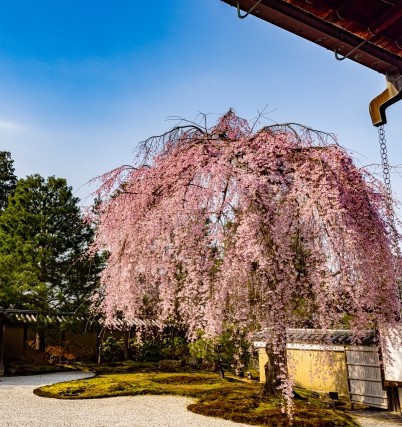
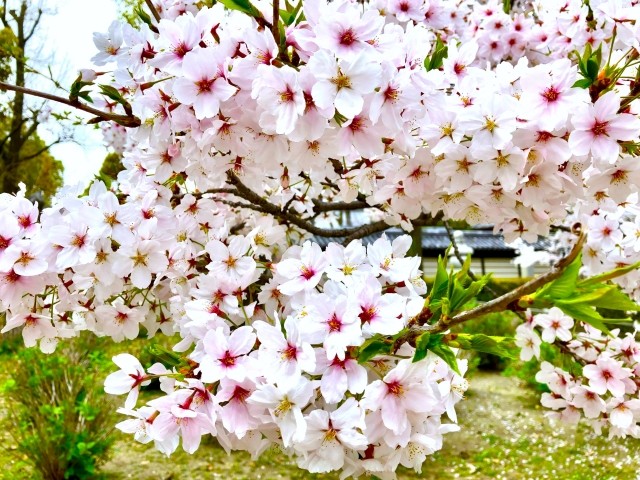
Tea and food using cherry blossom flowers
Cherry trees are used in confectionery and as foodstuffs. Cherry blossom flowers (usually pickled with salt are used to make sakurayu (steeping pickled cherry blossoms with boiled water often served at weddings).
Sakuramochi, a sweet, pink-coloured rice cake with red bean paste filling, is wrapped in a pickled cherry blossom leaf. The salted leaves used for the rice cakes are usually Oshima-zakura. Their leavesare large enough to roll into rice cakes and have few fuzzes. Rolling the leaves prevents the rice cake from drying out, giving it a sweet, floral aroma and a subtle salty flavour unique to cherry blossoms. The production process and appearance of sakura mochi differ between the Kanto and Kansai regions. The Kanto region tastes more like a crepe, while the Kansai region’s sakura mochi (‘domyo-ji’) has a more granular texture of glutinous rice.
There are also cherry-flavoured roll cakes or chocolates. These sweets, which use cherry blossom flowers, are popular, especially in spring.
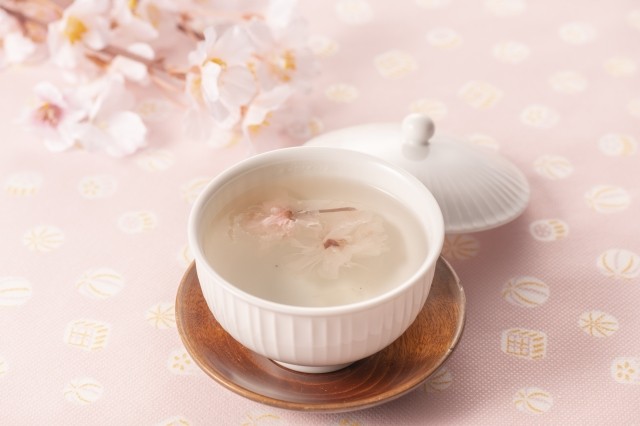
.jpeg)
Traditional crafts
Traditional crafts using cherry trees include kaba-zaiku in Akita prefecture, which is made from the bark of the yamazakura cherry tree. It has been produced for 250 years in Kakunodate-cho, Senboku City, Akita Prefecture, known as the Little Kyoto of the Tohoku region. Kaba-zaiku was industrialised in the late 18th century as a domestic occupation for low-ranking samurai. The unique technique makes the most of the special sheen of mountain cherry bark, and the natural patterns are fascinating as no two pieces are the same. Typical products include tea caddies, tables, letter boxes, tea-cabinets (‘chadansu’) and brooches.

Cherry blossoms’ flowering time and global warming
In recent years, cherry blossoms have started to bloom much earlier than 40 years ago. Cherry blossoms are highly sensitive to temperature, making them a natural indicator of climate change. Therefore, scientists and historians warn that cherry blossoms flowering earlier than ever should be mainly due to global warming.
The average maximum temperature in March in central Tokyo has been on an upward trend since the 1990s, when the flowering date began to come noticeably earlier, rising to 14.5°C in the 2010s, the highest since observations began in the 1870s. Likewise, the records show that cherry blossoms used to bloom in mid-April in Kyoto, but now they often bloom in late March. In 2021, Kyoto’s cherry blossoms reached full bloom on March 26, the earliest recorded date in 1,200 years!
It is difficult to predict what will happen in the future, but it is thought that if spring temperatures are higher, the growth of Somei-yoshino will also accelerate. Until 1988, Somei-yoshino did not flower in central Tokyo in April. But it seems flowering in March becomes the norm, and this will continue. The Japan Meteorological Agency forecasted cherry blossoms to bloom in late March in Tokyo and most of West Japan this year.
